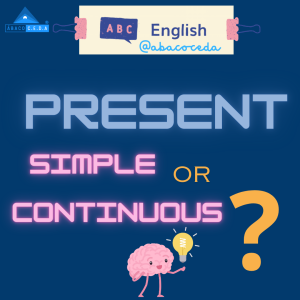PRESENT SIMPLE or CONTINUOUS?
 Present Simple or Present Continous? En este post vamos a explicaros las principales diferencias entre ambos tiempos ya que en bastantes ocasiones genera dudas.
Present Simple or Present Continous? En este post vamos a explicaros las principales diferencias entre ambos tiempos ya que en bastantes ocasiones genera dudas.
En primer lugar el PRESENT SIMPLE es el tiempo verbal que se usa en los siguientes casos:
- Para hablar de RUTINAS o HÁBITOS en el presente: Ex. I usually play tennis // He usually playS tennis
- Hechos científicos:Ex. Water boilS at 100 degrees
- Situaciones permanentes: Ex. I have a red car
- Stative verbs: Ex. I need some rest now
- Horarios en el futuro: Ex. The train leaveS at 10
PISTAS!!! ADVERBIOS DE FRECUENCIA ( always, never, usually, often…)
Sin embargo, el PRESENT CONTINUOUS se usa:
- Acciones que se realizan en este momento o de forma temporal:
Ex. I AM listenING to the radio now // He IS workING from Monday to Wednesday this week
- Planes fijos en el futuro: Ex. She IS meetING Sarah tomorrow
- Situaciones cambiantes: Ex. Your English is improving
PISTAS!! For example: at the moment, now, right now…
¿Y cómo se forma cada tiempo verbal?
La estructura del PRESENT SIMPLE es:
+) SUJETO + INFINITIVO ( si es 3º persona singular añade -S /-ES)
Ex. I play tennis // He playS tennis
-) SUJETO + DOESN´T / DON´T + INFINITIVO
Ex. I DONT play tennis // He DOESN’T play tennis
?) DO / DOES + SUJETO + INFNITIVO?
Ex. Do you live in Paris? / Does he live in Paris?
Por otro lado, la estructura del PRESENT CONTINUOUS es la siguiente:
+) SUJETO + AM / IS / ARE + VERBO -ING
Ex. I AM playING tennis // He IS playING tennis
-) SUJETO + AM NOT / ISN´T / AREN´T + VERBO -ING
Ex. I AM NOT playING tennis // He ISN´T playING tennis
?) AM / IS / ARE + SUJETO + VERBO-ING?
Ex. ARE you livING in Paris now? / IS he livING in Paris now?
¡Ahora solo queda practicar mucho! Por eso, os dejamos varios links donde podréis encontrar diversas actividades para que lo podáis ir aprendiendo poco a poco. ¡Esperamos que os haya servido de ayuda este post!
PRESENT SIMPLE 1 PRESENT SIMPLE 2 PRESENT SIMPLE 3
PRESENT CONTINUOUS 1 PRESENT CONTINUOUS 2 MIXED 1MIXED 2
